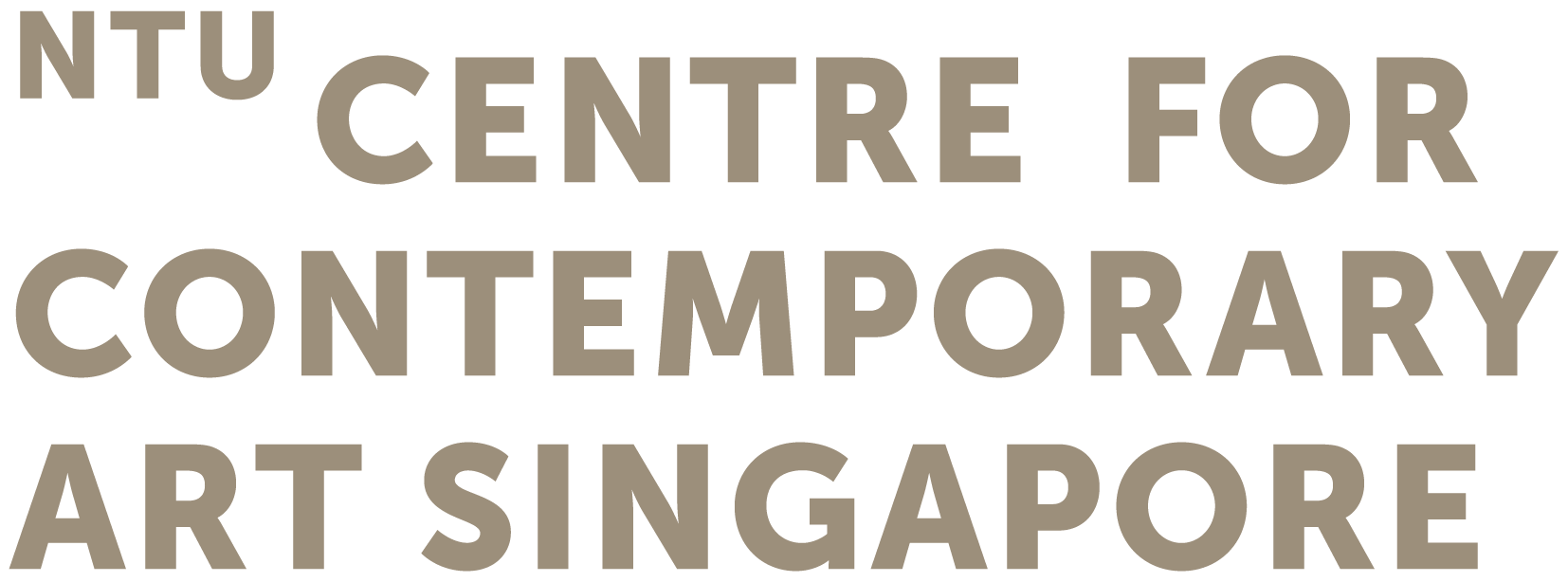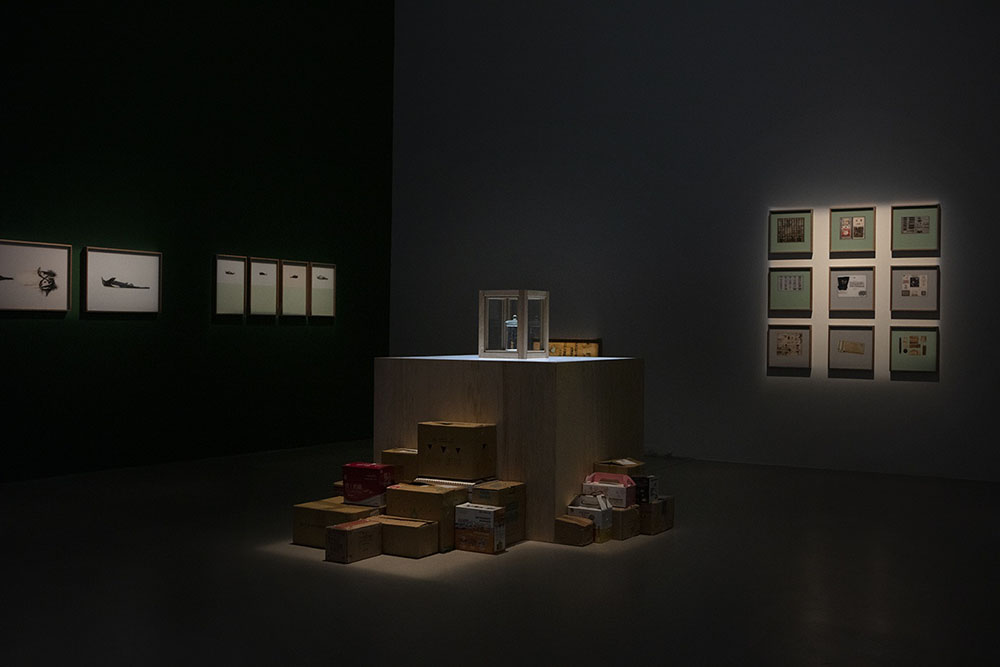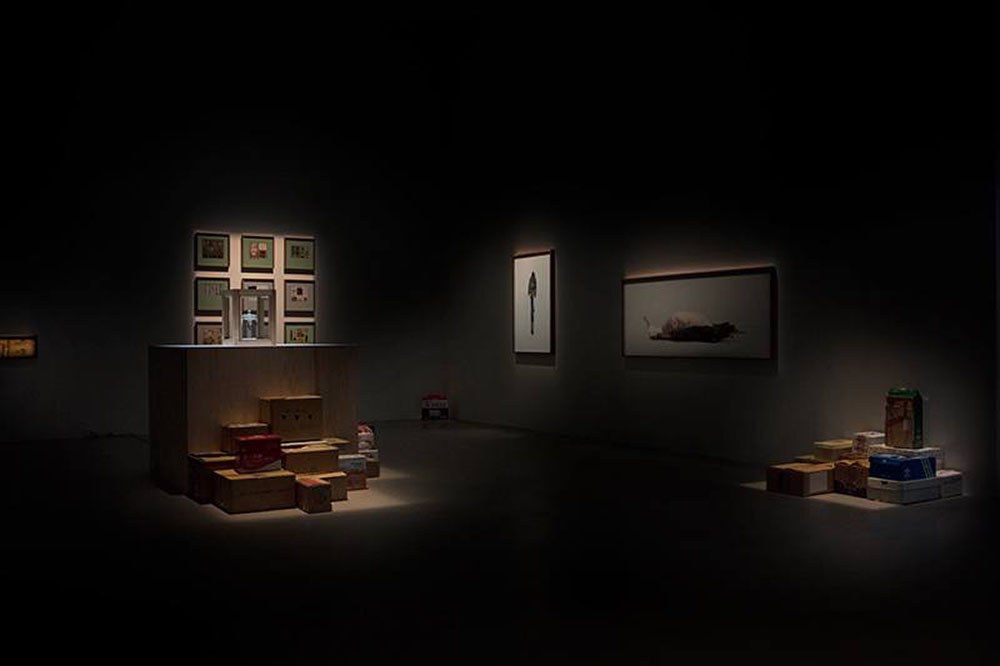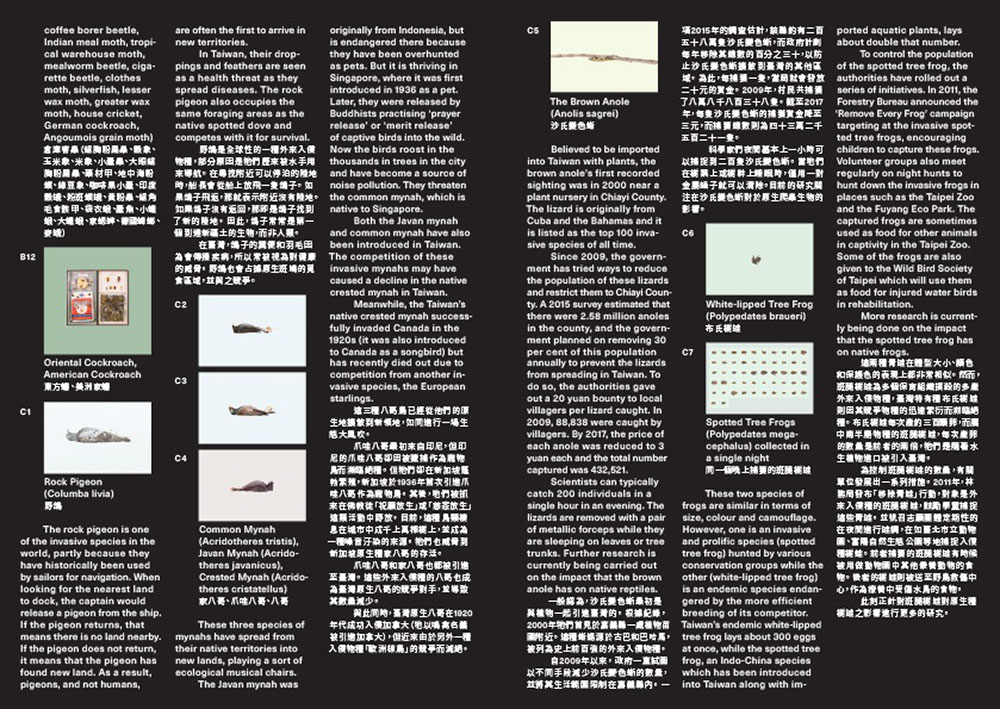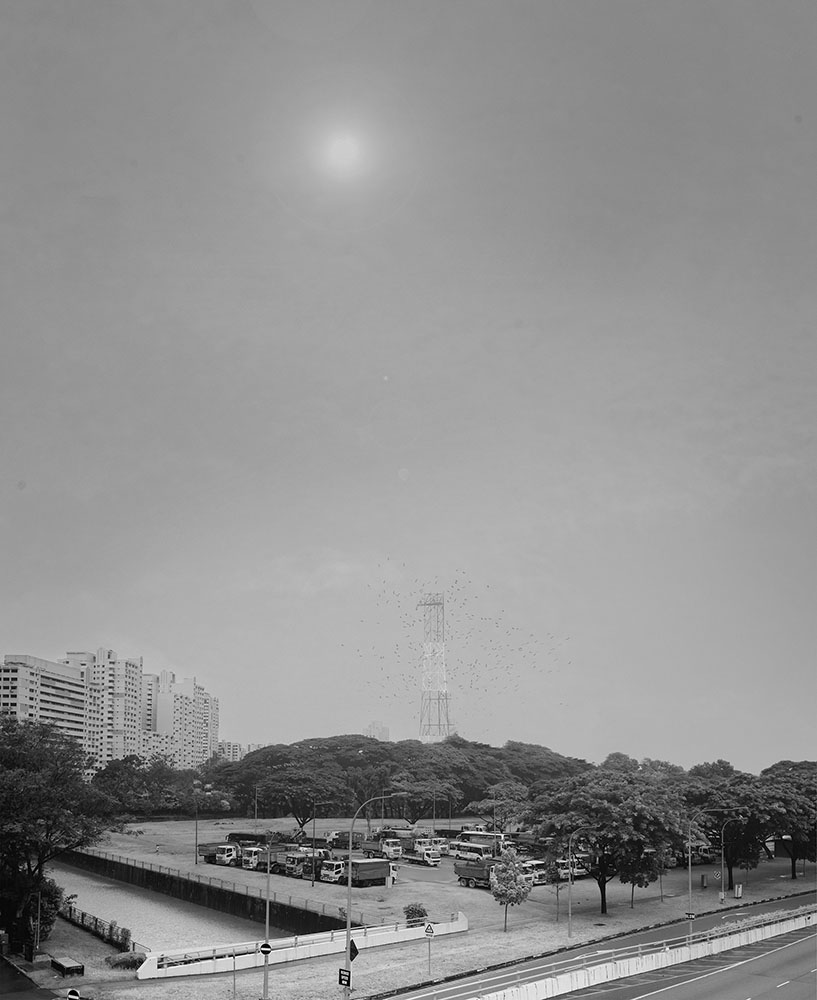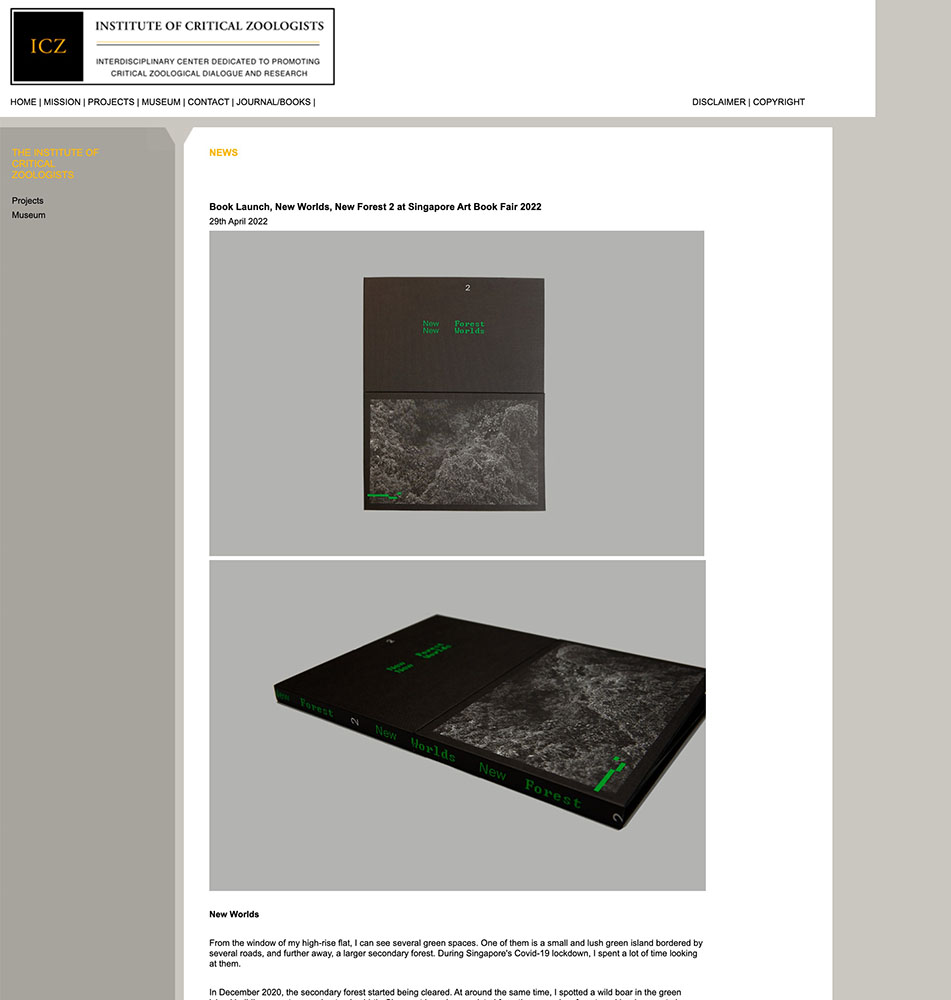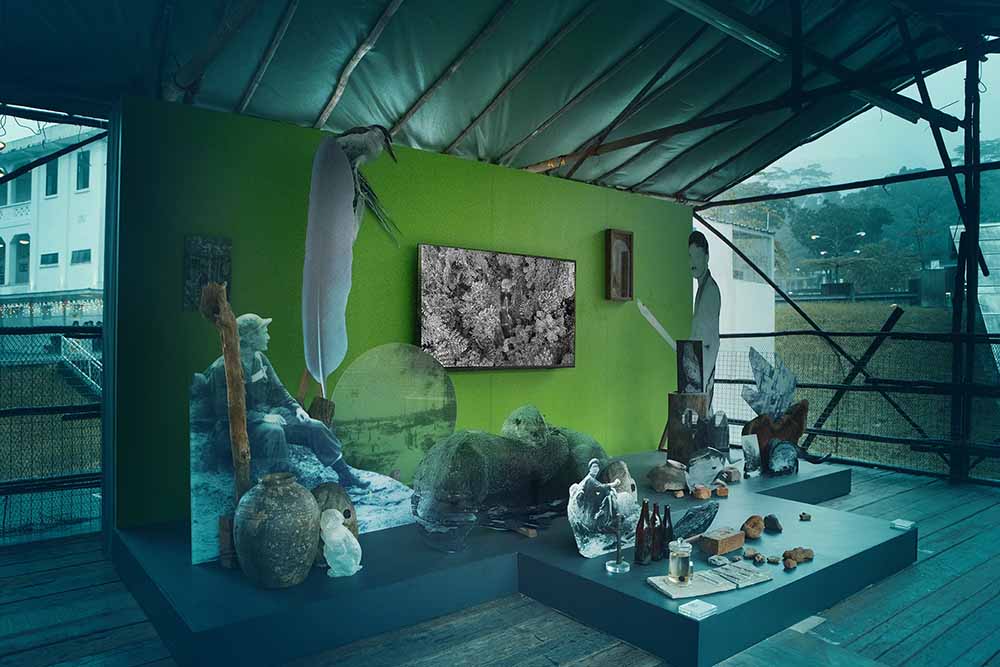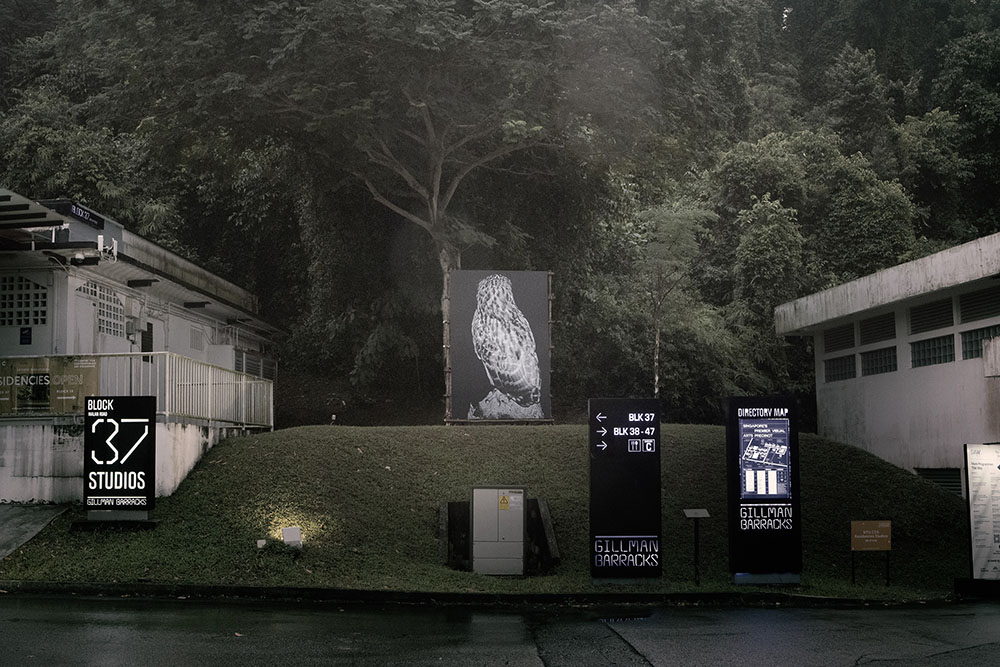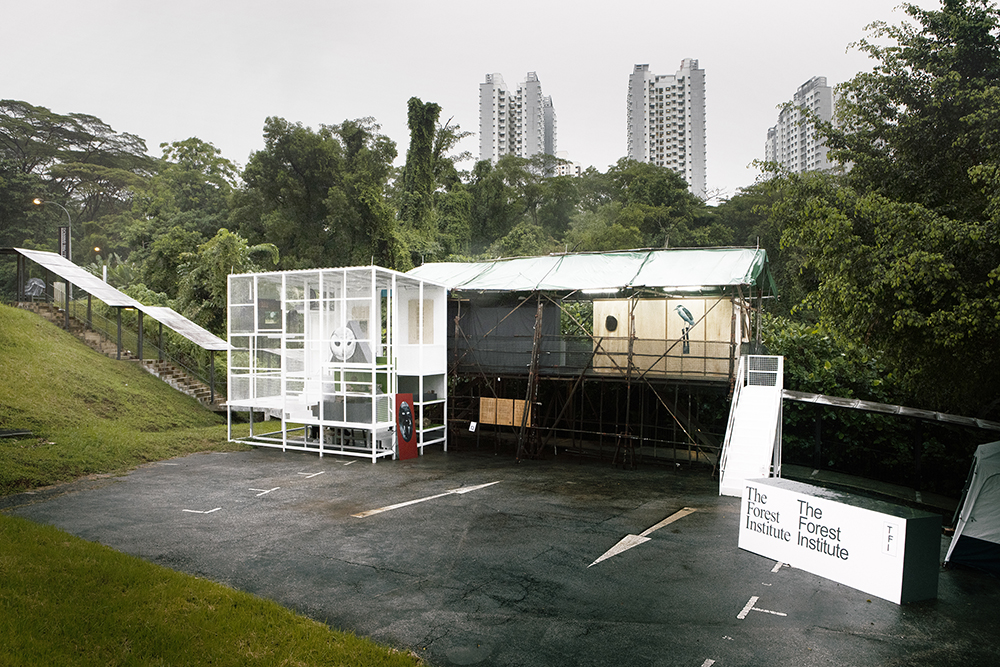
The Forest Institute, 2021, Robert Zhao. Courtesy of the artist.
Projects
When World Collides
This installation presents research on animal and insect specimens from Taiwan, Greece, and Germany alongside historical and contemporary narratives of human invasion, and considers the position of humans as foreign species.
For this work, Robert Zhao Renhui began his research in Taiwan, investigating a series of species removal plans: first, the artist discovered a local reward scheme for capturing invasive lizard species, which led in 2015 to over 220,000 lizards being caught in Chiayi, south Taiwan, alone. On the west coast of Taiwan, meanwhile, the African Sacred Ibis has recently arrived and is forcing out native birds, so experts are designing a nest removal plan. Finally, volunteers at Taipei Zoo are capturing Spot-legged Tree Frogs twice a week at night, and feeding them to zoo animals. These controls are entirely due to the belief that imported plants and animals threaten the species that we consider native, however the movement of species, and their categorisation, is largely a human consequence.
In addition to exploring the migration of species, Zhao’s work investigates the number of wild birds injured or killed on a weekly basis due to human action in both Taipei and Greece. Through studying x-rays from research institutions in Greece, and specimens collected by the Biodiversity Research Museum in Taiwan’s Academia Sinica, the artist has looked into the specific causes for these deaths and injuries, which include shooting, previous veterinary surgeries, and collisions with buildings or cars. This is also presented alongside this evidence is material on pests collated by the late German insect expert, Herbert Weidner. Pests are existing in a state of unease due to the endangerment of their ecosystem. Through these presentations, Zhao invites a rethinking of the commonly assumed hierarchies between humans and their fellow non-human beings.
Source: Museum臺北市立美術館 Taipei Fine Arts. “2018台北雙年展 TAIPEI BIENNIAL.” TAIPEI BIENNIAL 2018台北雙年展. Accessed October 2, 2023. https://www.taipeibiennial.org/2018/information/120.
A Great Sign Appeared
In ancient times, the observation of birds in flight was used in divinatory practices to decipher the present and foretell the future. A Great Sign Appeared captures the sudden arrival of thousands of Asian openbill storks in Singapore from northern parts of Southeast Asia on 22 December 2019. The artist followed the birds’ week-long futile and ultimately unsuccessful search for a suitable roosting site in the densely populated city-state. As we become increasingly aware that environmental changes and a drastic reduction of resources in their native lands are altering the behavioural patterns and migration routes of many species, the work invites us to ponder on the possible meanings of this unexpected occurrence and on the uncertain future that awaits the planet.
Institute of Critical Zoologists
“The Institute for Critical Zoologists aims to develop a critical approach to the zoological gaze, or how humans view animals. Urban societies live in relative isolation from animals; however, our demand and gaze upon them have grown significantly over the last century. It is undeniable that looking at animals is considered both desirable and pleasurable in societies. Animals convey meaning and values that are culture-specific, and in viewing the animal, we cannot escape the cultural context, political climate and social values in which that observation takes place.
The relationship between animals and humans has reached an appalling state. There is increased visual exploitation of animals (there are more than a thousand zoos in the world and twice as many natural history museums); and there is exploitation of animals as commodities (tiger parts are traded for commerce in China). Not to mention the environmental, ecological, cultural threats of zoos, animal performances, animal agriculture, poaching, economic-driven conservation biology, natural history museums displays and animal memorabilia, to which human anthropomorphism plays a pivotal role.
We seek to develop a critical zoological gaze that pursues creative, interdisciplinary research that includes perspectives typically ignored by animal studies, such as aesthetics; and to advance unconventional, even radical, means of understanding human and animal relations. The institute also discourages anthropomorphism in the appreciation and understanding of zoology.”
Check out more at the Institute of Critical Zoologists website here: https://www.criticalzoologists.org/
Source: www.criticalzoologists.org. “Institute of Critical Zoologists.” Accessed October 2, 2023. https://www.criticalzoologists.org/mission/mission.html
The Forest Institute
The Forest Institute is a large-scale architectural art installation housing a research installation comprising the Forest Observation Room and the River Platform, devoted to research on the secondary forest surrounding the Gillman Barracks precinct. Conceptualised by Robert Zhao & Randy Chan, and curated by John Tung, the Institute—which intervenes in existing pedestrian infrastructure—is accompanied by several large-scale prints of fauna installed in its vicinity, exposing visitors to the different realities of the area.
The project draws inspiration from and pays close attention to an ancient tributary of Berlayer Creek, that courses through the forested areas of the barracks within an earshot distance from the institute. Prompting an acute awareness of the interconnectedness and interdependence of the perceived ‘ecological pockets’ that we encounter within our built environments, The Forest Institute offers a glimpse at the beauty and mysteries that nature has to offer while pre-empting us on what we stand to lose.
Extending from research undertaken by Robert Zhao Renhui for his Benesse Prize finalist artwork, Queen’s Own Hill and its Environs, commissioned and presented at the Singapore Biennale 2019, and conceptualised in collaboration with award-winning architect-artist Randy Chan, The Forest Institute exists as a large-scale architectural art installation housing a research installation comprising the Forest Observation Room and the River Platform, devoted to research on the secondary forest surrounding the Gillman Barracks precinct. The Institute, accompanied by several large-scale prints of fauna—encountered and observed within the forested area—installed in its vicinity, exposes visitors to the different realities of the area.
Drawing inspiration from Southeast Asian architecture, the design of the institute is reminiscent of the Bornean longhouse—one of the earliest forms of permanent structures for many cultures around the world—albeit with the incorporation of a contemporary steel wing. Intervening into the existing pedestrian infrastructure present within the arts site, Chan’s architectural design highlights the backdrop of nature against the urban reality. Drawing attention to the forest that surrounds the concretised barracks, the elevated institute offers a unique vantage point to peer into the green yonder.
While housing research findings from Zhao’s extensive engagement with the history, botany, and zoology of the forest surrounding the Gillman Barracks art precinct over the past four years, the institute also provides visiting researchers with the opportunity for an extended study of the forest through overnight residencies at the Forest Observation Room. Equipped with provisions capable of supporting up to 2 adult and 2 child researchers from dusk to dawn, the observation room provides a safe refuge for the scrutiny of the forest’s nocturnal inhabitants.
Finally, the River Platform will lead visitors beyond demarcated boundaries to one of the key sites of interest, for both Chan & Zhao, within the forest—an ancient tributary draining into Berlayer Creek, concretised by the British, and still flowing today. Just as how this “river” serves as a source of sustenance for the fauna that inhabit the area, its flowing waters are simultaneously the wellspring of the artists’ inspiration.
Berlayer Creek, one of two remaining mangrove swamps located in the south of Mainland Singapore, possesses the longest history of urbanisation amongst all mangrove swamps in Singapore, having been occupied since the 1820s. Now a refuge for numerous species of migratory birds and other animals, the recognition of this humble stream running through the forests of Gillman Barracks as one of its tributaries—predating settlement, colonisation, and urbanisation—prompts an acute awareness of the interconnectedness and interdependence of the perceived ‘ecological pockets’ that we encounter within our built environments.
As an ongoing study of the enmeshment and impact of human activities on surrounding ecologies, The Forest Institute emerges as an allegory of humanity’s limited understanding of our natural surroundings. Beyond offering a glimpse at nature's beauty and mysteries, the artwork preempts us on what we stand to lose.
Biography
Robert Zhao Renhui (b. 1983, Singapore) is a Singapore artist with an interdisciplinary practice. Over the past eight years, he has rooted the pressing topic of the Anthropocene to his Singaporean environment, investigating the potential of secondary forests as key sites of regeneration and regrowth. He is the founder of the Institute of Critical Zoologists, an interdisciplinary centre dedicated to promoting critical zoological dialogue and research.
Zhao received his master's degree in photography from London College of Communication. He has exhibited globally in international biennales and institutions around the world, most recently at the 9th Asia Pacific Triennial of Contemporary Art’ (APT9). He received the Young Artist Award by the National Arts Council Singapore in 2010. Zhao is the featured artist for the Singapore Pavilion at the 60th International Art Exhibition – La Biennale di Venezia (2024).
Selected Exhibitions
Selected Solo Exhibitions
2022 The Forest Institute, Gillman Barracks, Singapore
2020 Robert Zhao Renhui: The Lines We Draw, ShanghART Singapore,Singapore
2019 The Lines We Draw, Yalu River Art Museum, Dandong, China
2019 New Forest, Mind Set Art Center, Taipei, Taiwan
2018 Final Report of the Christmas Island Expert Working Group, NTU Centre for Contemporary Art, Singapore
2017 Christmas Island, Naturally, ShanghART M50, Shanghai, China
2017 The Nature Museum, commissioned by Singapore International Festival of Arts, 72-13, Singapore
2017 Christmas Island, Naturally, ShanghART Singapore, Singapore
2017 Singapore, Very Old Tree, National Museum of Singapore, Singapore
2016 The Natural History of an Island, DECK, Singapore
2015 A Guide to the Flora and Fauna of the World, Centre for Contemporary Photography, Melbourne, Australia
2015 The Tree that fell, The Substation, Singapore
2015 The Nature Collector, ShanghAR Gallery, Shanghai, China
Selected Group Exhibitions
2022 Cuttings, Mizuma Art Gallery, Singapore
2022 Silent Spring, Galerie im Körnerpark, Berlin, Germany
2022 The Natural History of an Island, Three Shadows Photography Art Center, Beijing, China
2022 Free Jazz IV. Geomancers, NTU CCA, Singapore
2022 Rediscovering Lost Connections, Silvana S Foundation, JADA Art Gallery, Singapore
2021 Chengdu Biennale, Super Fusion, Tianfu Art Park, Chengdu
2021 Posthuman Ensemble, Asia Culture Center, Gwangju, South Korea
2021 Interspecies Futures, Center for Book Arts, New York, United States
2021 ANTHROPOLOGY OF ICE, Fotograf Festival 11, Fotograf Gallery, Prague, Czech Republic
2020 From the Mundane World, Launch Exhibition of He Art Museum, He Art Museum, Guangdong
2020 In The Forest, Even The Air Breathes, GAMeC Galleria d'Arte Moderna e Contemporanea, Bergamo, Italy
2020 The Seeds We Sow, Mizuma Gallery, Singapore
2019 Winter Exhibition, ShanghART Beijing, Beijing
2019 2219: Futures Imagined, ArtScience Museum, Singapore
2019 Singapore Biennale 2019, Every Step in the Right Direction, Gillman Barracks, Singapore
2019 Observe, Experiment, Archive, Sunderland Museum and Winter Garden, London, United Kingdom
2019 The Time Tree, Fort Canning Park, Singapore
2018 The 9th Asia Pacific Triennial of Contemporary Art (APT9), The Queensland Art Gallery | Gallery of Modern Art, Brisbane, Australia
2018 Post-Nature—A Museum as an Ecosystem: Taipei Biennial 2018, Taipei Fine Arts Museum, Taipei, Taiwan
2018 From the Archives, Mizuma Gallery, Singapore
Selected Residencies
Residency at Earth Observatory Singapore
The Possibility of Knowing, 2013
The 'Possibility of Knowing' is part of a project of images about the Indonesian cities of Padang and Banda Aceh that compares the before and after of a natural disaster. The project examines the tension and the fragility of landscapes in areas that are subject to such hazards. Zhao drew inspiration from the methodologies and techniques used by Earth scientists he encountered at the Earth Observatory Singapore, to interpret the natural forces behind Earth hazards.
"The six projects produced between 2010 and 2013 under the art residencies at EOS are inspired by Earth science, natural hazards, and humans living in high risk areas. These interdisciplinary projects were showcased at the Singapore Art Museum as part of the Unearthed exhibition, and augmented with a series of seminars for young students about the interactions of science and art."
Check out Zhao's interview with Art-Science-Media on his project The Possibility of Knowing here: https://art-science-media.com/the-possibility-of-knowing/
Selected Awards
2021 Excellence Award, New Cosmos of Photography 2021, Tokyo, Japan
2019 Finalist, 12th Benesse Prize, Singapore Art Museum, Singapore
2014 Finalist, APB Foundation Signature Art Prize, Singapore Art Museum, Singapore
2011 Deutsche Bank Award In Photography, University of the Arts, London, UK
2010 Young Artist Award, Singapore
2009 Arts Creation Fund, National Arts Council, Singapore United Overseas Bank Prize, Painting of the Year Award, Singapore
